Impacts of Water and Sediment Fluxes into the Sea on Spatiotemporal Evolution of Coastal Zone in the Yellow River Delta
Abstract
1. Introduction
2. Materials and Methods
2.1. Study Area
2.2. Data Sources
2.3. Trend and Change Point Detection
2.4. Extraction of Coastlines
2.5. Assessing the YRD Evolution
3. Results
3.1. Variations in Water and Sediment Fluxes
3.2. Spatiotemporal Evolution of YRD
3.2.1. Overall Evolution of YRD
3.2.2. Evolution of the Qingshuigou Region
3.2.3. Evolution of the Diaokou Region
3.2.4. Migration of the Gravity Center
3.3. Quantitative Relationship Between YRD Evolution and Sediment Flux
4. Discussion
4.1. Staged Changes in Water–Sediment Fluxes
4.2. Evolution Pattern of the Yellow River Delta
4.3. Relationship Between Sediment Flux and Land Accretion Area
4.4. Implications and Limitations
5. Conclusions
Supplementary Materials
Author Contributions
Funding
Data Availability Statement
Conflicts of Interest
References
- Elsey-Quirk, T.; Graham, S.A.; Mendelssohn, I.A.; Snedden, G.; Day, J.W.; Twilley, R.R.; Shaffer, G.; Sharp, L.A.; Pahl, J.; Lane, R.R. Mississippi river sediment diversions and coastal wetland sustainability: Synthesis of responses to freshwater, sediment, and nutrient inputs. Estuar. Coast. Shelf Sci. 2019, 221, 170–183. [Google Scholar] [CrossRef]
- Giosan, L.; Syvitski, J.; Constantinescu, S.; Day, J. Climate change: Protect the world’s deltas. Nature 2014, 516, 31–33. [Google Scholar] [CrossRef] [PubMed]
- Schuerch, M.; Spencer, T.; Temmerman, S.; Kirwan, M.L.; Wolff, C.; Lincke, D.; McOwen, C.J.; Pickering, M.D.; Reef, R.; Vafeidis, A.T.; et al. Future response of global coastal wetlands to sea-level rise. Nature 2018, 561, 231–234. [Google Scholar] [CrossRef]
- Li, L.; Ni, J.; Chang, F.; Yue, Y.; Frolova, N.; Magritsky, D.; Borthwick, A.G.L.; Ciais, P.; Wang, Y.; Zheng, C.; et al. Global trends in water and sediment fluxes of the world’s large rivers. Sci. Bull. 2020, 65, 62–69. [Google Scholar] [CrossRef] [PubMed]
- Bussi, G.; Darby, S.E.; Whitehead, P.G.; Jin, L.; Dadson, S.J.; Voepel, H.E.; Vasilopoulos, G.; Hackney, C.R.; Hutton, C.; Berchoux, T.; et al. Impact of dams and climate change on suspended sediment flux to the Mekong delta. Sci. Total Environ. 2021, 755, 142468. [Google Scholar] [CrossRef]
- Yin, S.; Gao, G.; Ran, L.; Lu, X.; Fu, B. Spatiotemporal variations of sediment discharge and in-reach sediment budget in the Yellow River from the headwater to the delta. Water Resour. Res. 2021, 57, e2021WR030130. [Google Scholar] [CrossRef]
- Lämmle, L.; Perez Filho, A.; Donadio, C.; Arienzo, M.; Ferrara, L.; Santos, C.d.J.; Souza, A.O. Anthropogenic pressure on hydrographic basin and coastal erosion in the delta of Paraíba do Sul River, Southeast Brazil. J. Mar. Sci. Eng. 2022, 10, 1585. [Google Scholar] [CrossRef]
- Molina, R.; Manno, G.; Villar, A.C.d.; Jigena-Antelo, B.; Muñoz-Pérez, J.J.; Cooper, J.A.G.; Pranzini, E.; Anfuso, G. The effects of anthropic structures on coastline morphology: A case study from the Málaga Coast (Spain). J. Mar. Sci. Eng. 2025, 13, 319. [Google Scholar] [CrossRef]
- Edmonds, D.A.; Toby, S.C.; Siverd, C.G.; Twilley, R.; Bentley, S.J.; Hagen, S.; Xu, K. Land loss due to human-altered sediment budget in the Mississippi River Delta. Nat. Sustain. 2023, 6, 644–651. [Google Scholar] [CrossRef]
- El Banna, M.M.; Frihy, O.E. Human-induced changes in the geomorphology of the northeastern coast of the Nile delta, Egypt. Geomorphology 2009, 107, 72–78. [Google Scholar] [CrossRef]
- Li, X.; Liu, J.P.; Saito, Y.; Nguyen, V.L. Recent evolution of the Mekong Delta and the impacts of dams. Earth Sci. Rev. 2017, 175, 1–17. [Google Scholar] [CrossRef]
- Vericat, D.; Batalla, R.J. Sediment transport in a large impounded river: The lower Ebro, NE Iberian Peninsula. Geomorphology 2006, 79, 72–92. [Google Scholar] [CrossRef]
- Luo, J.; Dai, Z.; Wang, J.; Lou, Y.; Zhou, X.; Tang, R. Effects of human-induced riverine sediment transfer on deposition–erosion in the South Passage of the Changjiang (Yangtze) delta. J. Hydrol. 2023, 622, 129714. [Google Scholar] [CrossRef]
- Yu, B.; Zang, Y.; Wu, C.; Zhao, Z. Spatiotemporal dynamics of wetlands and their future multi-scenario simulation in the Yellow River Delta, China. J. Environ. Manag. 2024, 353, 120193. [Google Scholar] [CrossRef]
- Wang, S.; Fu, B.; Piao, S.; Lü, Y.; Ciais, P.; Feng, X.; Wang, Y. Reduced sediment transport in the Yellow River due to anthropogenic changes. Nat. Geosci. 2016, 9, 38–41. [Google Scholar] [CrossRef]
- Wang, H.; Bi, N.; Saito, Y.; Wang, Y.; Sun, X.; Zhang, J.; Yang, Z. Recent changes in sediment delivery by the Huanghe (Yellow River) to the sea: Causes and environmental implications in its estuary. J. Hydrol. 2010, 391, 302–313. [Google Scholar] [CrossRef]
- Wang, H.; Yang, Z.; Saito, Y.; Liu, J.P.; Sun, X.; Wang, Y. Stepwise decreases of the Huanghe (Yellow River) sediment load (1950–2005): Impacts of climate change and human activities. Glob. Planet. Change 2007, 57, 331–354. [Google Scholar] [CrossRef]
- Ji, H.; Chen, S.; Pan, S.; Xu, C.; Jiang, C.; Fan, Y. Morphological variability of the active Yellow River mouth under the new regime of riverine delivery. J. Hydrol. 2018, 564, 329–341. [Google Scholar] [CrossRef]
- Wang, H.; Wu, X.; Bi, N.; Syvitski, J.; Saito, Y. Impacts of the dam-orientated water-sediment regulation scheme on the lower reaches and delta of the Yellow River (Huanghe): A review. Glob. Planet. Change 2017, 157, 93–113. [Google Scholar] [CrossRef]
- Yi, Y.; Wang, X.; Liu, Q.; Zhang, J.; Yi, Q. Influence of water–sediment regulation scheme on accretion and erosion in a river delta: A case study of the Yellow River Delta, China. Estuaries Coasts 2022, 45, 1879–1887. [Google Scholar] [CrossRef]
- Meng, L.; Wang, L.; Wang, Q.; Zhao, J.; Zhang, G.; Zhan, C.; Liu, X.; Cui, B.; Zeng, L. Geochemical characteristics of the modern Yellow River Delta sediments and their response to evolution of the sedimentary environment. Front. Mar. Sci. 2024, 11, 1370336. [Google Scholar] [CrossRef]
- Sun, Z.; Niu, X. Variation tendency of coastline under natural and anthropogenic disturbance around the abandoned Yellow River Delta in 1984-2019. Remote Sens. 2021, 13, 3391. [Google Scholar] [CrossRef]
- Bi, N.; Wang, H.; Wu, X.; Saito, Y.; Xu, C.; Yang, Z. Phase change in evolution of the modern Huanghe (Yellow River) Delta: Process, pattern, and mechanisms. Mar. Geol. 2021, 437, 106516. [Google Scholar] [CrossRef]
- Liu, Z.; Xu, N.; Wang, J. Satellite-observed evolution dynamics of the Yellow River Delta in 1984-2018. IEEE J. Sel. Top. Appl. Earth Obs. Remote Sens. 2020, 13, 6044–6050. [Google Scholar] [CrossRef]
- Kong, D.; Miao, C.; Borthwick, A.G.; Duan, Q.; Liu, H.; Sun, Q.; Ye, A.; Di, Z.; Gong, W. Evolution of the Yellow River Delta and its relationship with runoff and sediment load from 1983 to 2011. J. Hydrol. 2015, 520, 157–167. [Google Scholar] [CrossRef]
- Zhou, Y.; Huang, H.Q.; Nanson, G.C.; Huang, C.; Liu, G. Progradation of the Yellow (Huanghe) River delta in response to the implementation of a basin-scale water regulation program. Geomorphology 2015, 243, 65–74. [Google Scholar] [CrossRef]
- Cui, B.L.; Li, X.Y. Coastline change of the Yellow River estuary and its response to the sediment and runoff (1976–2005). Geomorphology 2011, 127, 32–40. [Google Scholar] [CrossRef]
- Wu, X.; Bi, N.; Xu, J.; Nittrouer, J.A.; Yang, Z.; Saito, Y.; Wang, H. Stepwise morphological evolution of the active Yellow River (Huanghe) delta lobe (1976–2013): Dominant roles of riverine discharge and sediment grain size. Geomorphology 2017, 292, 115–127. [Google Scholar] [CrossRef]
- Li, S.N.; Wang, G.X.; Deng, W.; Hu, Y.M.; Hu, W.W. Influence of hydrology process on wetland landscape pattern: A case study in the Yellow River Delta. Ecol. Eng. 2009, 35, 1719–1726. [Google Scholar] [CrossRef]
- Zhu, Q.; Li, P.; Li, Z.; Pu, S.; Wu, X.; Bi, N.; Wang, H. Spatiotemporal changes of coastline over the Yellow River Delta in the previous 40 years with optical and SAR remote sensing. Remote Sens. 2021, 13, 1940. [Google Scholar] [CrossRef]
- Chu, Z.X.; Sun, X.G.; Zhai, S.K.; Xu, K.H. Changing pattern of accretion/erosion of the modern Yellow River (Huanghe) subaerial delta, China: Based on remote sensing images. Mar. Geol. 2006, 227, 13–30. [Google Scholar] [CrossRef]
- Cui, B.; He, Q.; An, Y. Community structure and abiotic determinants of salt marsh plant zonation vary across topographic gradients. Estuaries Coasts 2011, 34, 459–469. [Google Scholar] [CrossRef]
- Ning, Z.; Cui, B.; Chen, C.; Xie, T.; Gao, W.; Zhang, Y.; Zhu, Z.; Shao, D.; Li, D.; Bai, J. Tidal channel meanders serve as stepping-stones to facilitate cordgrass landward spread by creating invasion windows. Ecol. Appl. 2023, 34, e2813. [Google Scholar] [CrossRef] [PubMed]
- Mann, H.B. Nonparametric tests against trend. Econometrica 1945, 13, 245–259. [Google Scholar] [CrossRef]
- Hassan, M.A.; Church, M.; Yan, Y.; Slaymaker, O. Spatial and temporal variation of in-reach suspended sediment dynamics along the mainstem of Changjiang (Yangtze River), China. Water Resour. Res. 2010, 46, W11551. [Google Scholar] [CrossRef]
- Li, C.; Zhu, L.; Dai, Z.; Wu, Z. Study on spatiotemporal evolution of the Yellow River Delta coastline from 1976 to 2020. Remote Sens. 2021, 13, 4789. [Google Scholar] [CrossRef]
- Lefever, D.W. Measuring geographic concentration by means of the standard deviational ellipse. Am. J. Sociol. 1926, 32, 88–94. [Google Scholar] [CrossRef]
- Wang, F.; Wang, Z.; Yang, H.; Zhao, Y. Study of the temporal and spatial patterns of drought in the Yellow River basin based on SPEI. Sci. China Earth Sci. 2018, 61, 1098–1111. [Google Scholar] [CrossRef]
- Gardner, L.R. Assessing the effect of climate change on mean annual runoff. J. Hydrol. 2009, 379, 351–359. [Google Scholar] [CrossRef]
- Zhao, Q.; Tian, G.; Jing, X.; Hu, H. Impact of economic development and environmental regulations on greywater footprint loads in the Yellow River Basin in China. Ecol. Ind. 2023, 154, 110586. [Google Scholar] [CrossRef]
- Liu, Y.; Song, H.; An, Z.; Sun, C.; Trouet, V.; Cai, Q.; Liu, R.; Leavitt, S.W.; Song, Y.; Li, Q.; et al. Recent anthropogenic curtailing of Yellow River runoff and sediment load is unprecedented over the past 500 y. Proc. Natl. Acad. Sci. USA 2020, 117, 18251–18257. [Google Scholar] [CrossRef] [PubMed]
- Xu, B.; Yang, D.; Burnett, W.C.; Ran, X.; Yu, Z.; Gao, M.; Diao, S.; Jiang, X. Artificial water sediment regulation scheme influences morphology, hydrodynamics and nutrient behavior in the Yellow River estuary. J. Hydrol. 2016, 539, 102–112. [Google Scholar] [CrossRef]
- Liang, W.; Bai, D.; Wang, F.; Fu, B.; Yan, J.; Wang, S.; Yang, Y.; Long, D.; Feng, M. Quantifying the impacts of climate change and ecological restoration on streamflow changes based on a Budyko hydrological model in China’s Loess Plateau. Water Resour. Res. 2015, 51, 6500–6519. [Google Scholar] [CrossRef]
- Wu, X.; Bi, N.; Syvitski, J.; Saito, Y.; Xu, J.; Nittrouer, J.A.; Bianchi, T.S.; Yang, Z.; Wang, H. Can reservoir regulation along the Yellow River be a sustainable way to save a sinking delta? Earth’s Future 2020, 8, e2020EF001587. [Google Scholar] [CrossRef]
- Yu, J.; Fu, Y.; Li, Y.; Han, G.; Wang, Y.; Zhou, D.; Meixner, F.X. Effects of water discharge and sediment load on evolution of modern Yellow River Delta, China, over the period from 1976 to 2009. Biogeosciences 2011, 8, 2427–2435. [Google Scholar] [CrossRef]
- Ji, H.; Chen, S.; Pan, S.; Xu, C.; Tian, Y.; Li, P.; Liu, Q.; Chen, L. Fluvial sediment source to sink transfer at the Yellow River Delta: Quantifications, causes, and environmental impacts. J. Hydrol. 2022, 608, 127622. [Google Scholar] [CrossRef]
- Zhang, L.; Xing, H.; Li, P.; Ma, P.; Shi, H. Analysis of the evolution of the Yellow River Delta coastline and the response of the tidal current field. Front. Mar. Sci. 2023, 10, 1232060. [Google Scholar] [CrossRef]
- Shi, H.; Ma, P.; Sun, J.; Zhao, S.; Ma, R.; Li, L.; Zhan, C.; Liang, H. Study on the response mechanism of the Yellow River delta region to the cold wave process. Front. Mar. Sci. 2024, 11, 1430823. [Google Scholar] [CrossRef]
- Wang, Y.; Wang, S.; Zhao, W.; Liu, Y. The increasing contribution of potential evapotranspiration to severe droughts in the Yellow River basin. J. Hydrol. 2022, 605, 127310. [Google Scholar] [CrossRef]
- Xia, X.; Dong, J.; Wang, M.; Xie, H.; Xia, N.; Li, H.; Zhang, X.; Mou, X.; Wen, J.; Bao, Y. Effect of water-sediment regulation of the Xiaolangdi reservoir on the concentrations, characteristics, and fluxes of suspended sediment and organic carbon in the Yellow River. Sci. Total Environ. 2016, 571, 487–497. [Google Scholar] [CrossRef]
- Xie, C.; Cui, B.; Xie, T.; Yu, S.; Liu, Z.; Chen, C.; Ning, Z.; Wang, Q.; Zou, Y.; Shao, X. Hydrological connectivity dynamics of tidal flat systems impacted by severe reclamation in the Yellow River Delta. Sci. Total Environ. 2020, 739, 139860. [Google Scholar] [CrossRef] [PubMed]
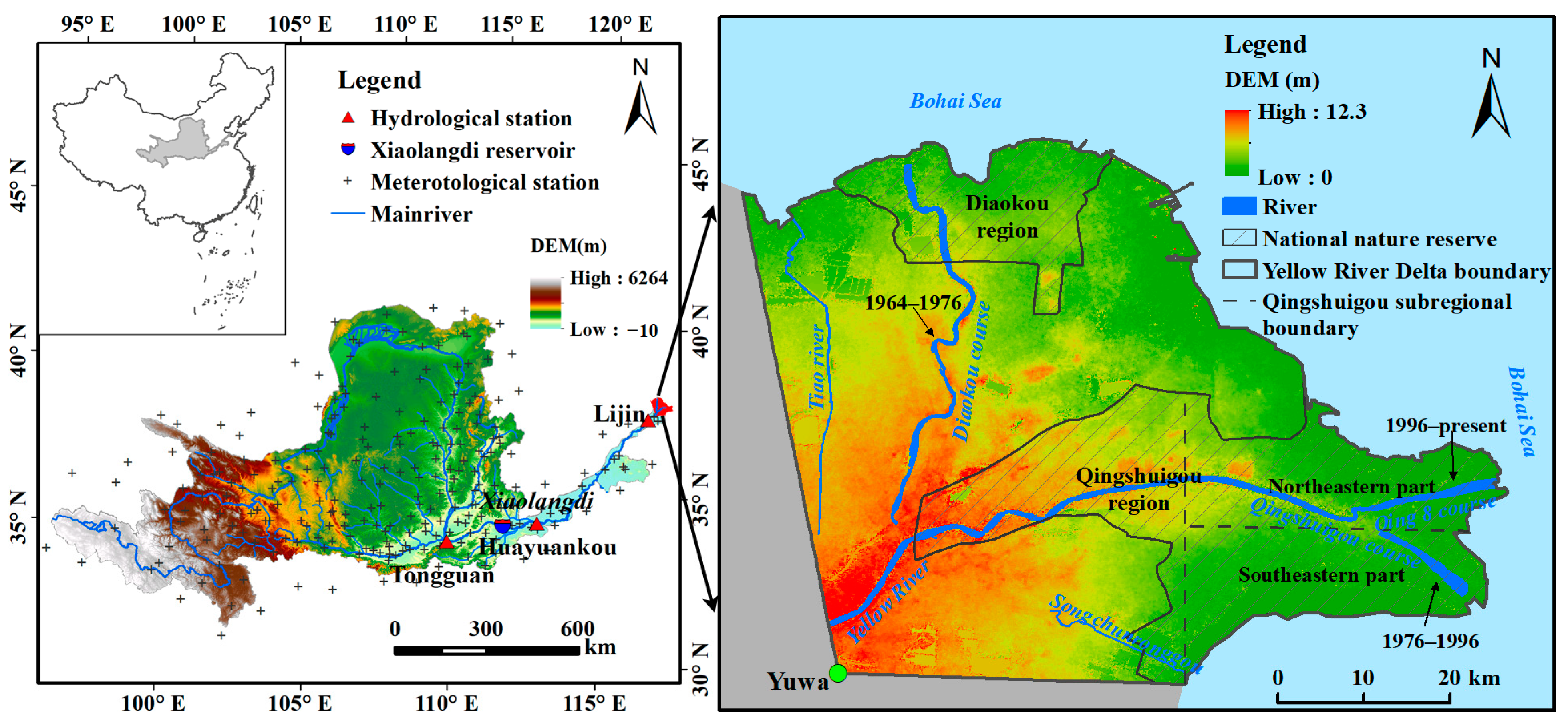
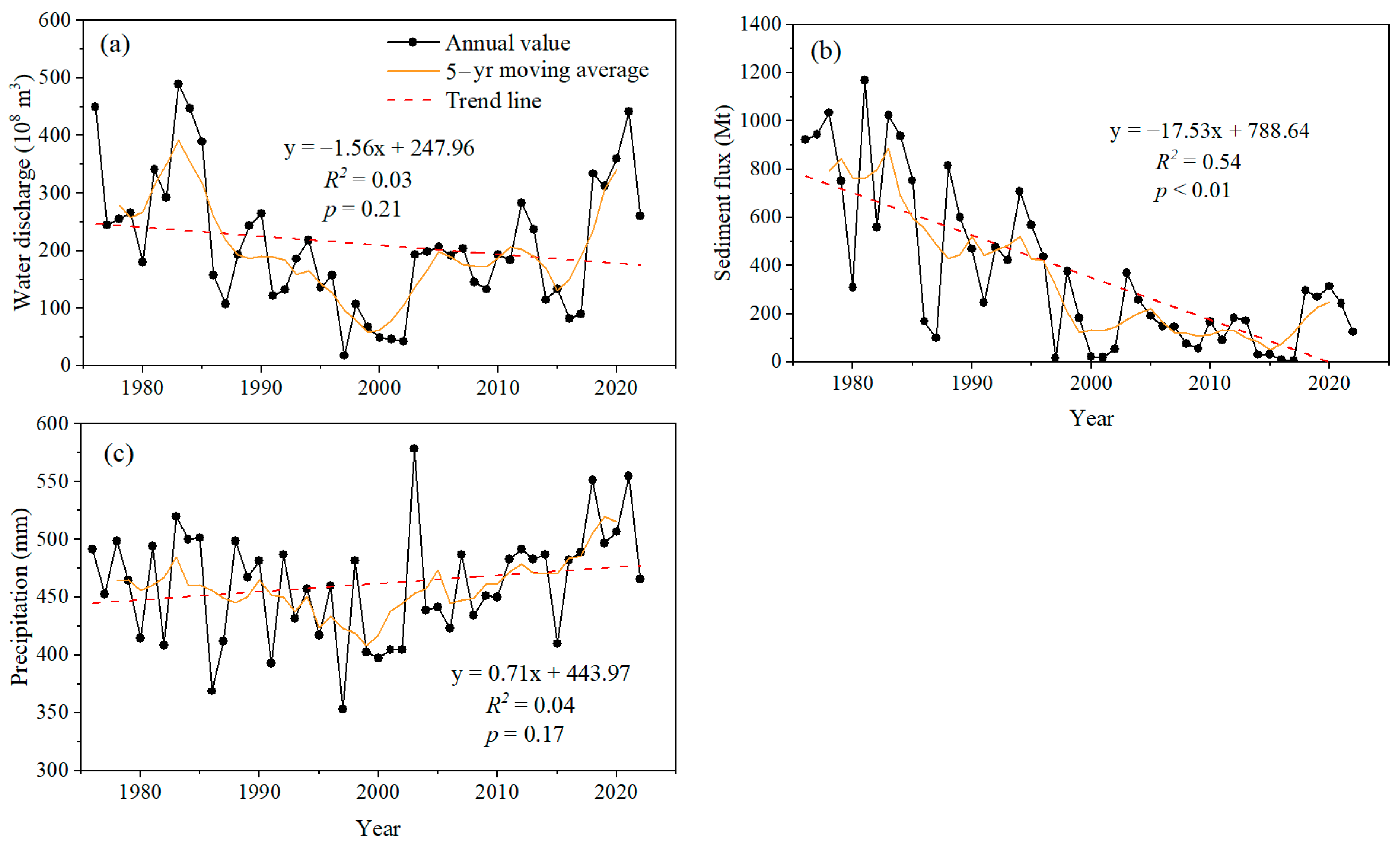

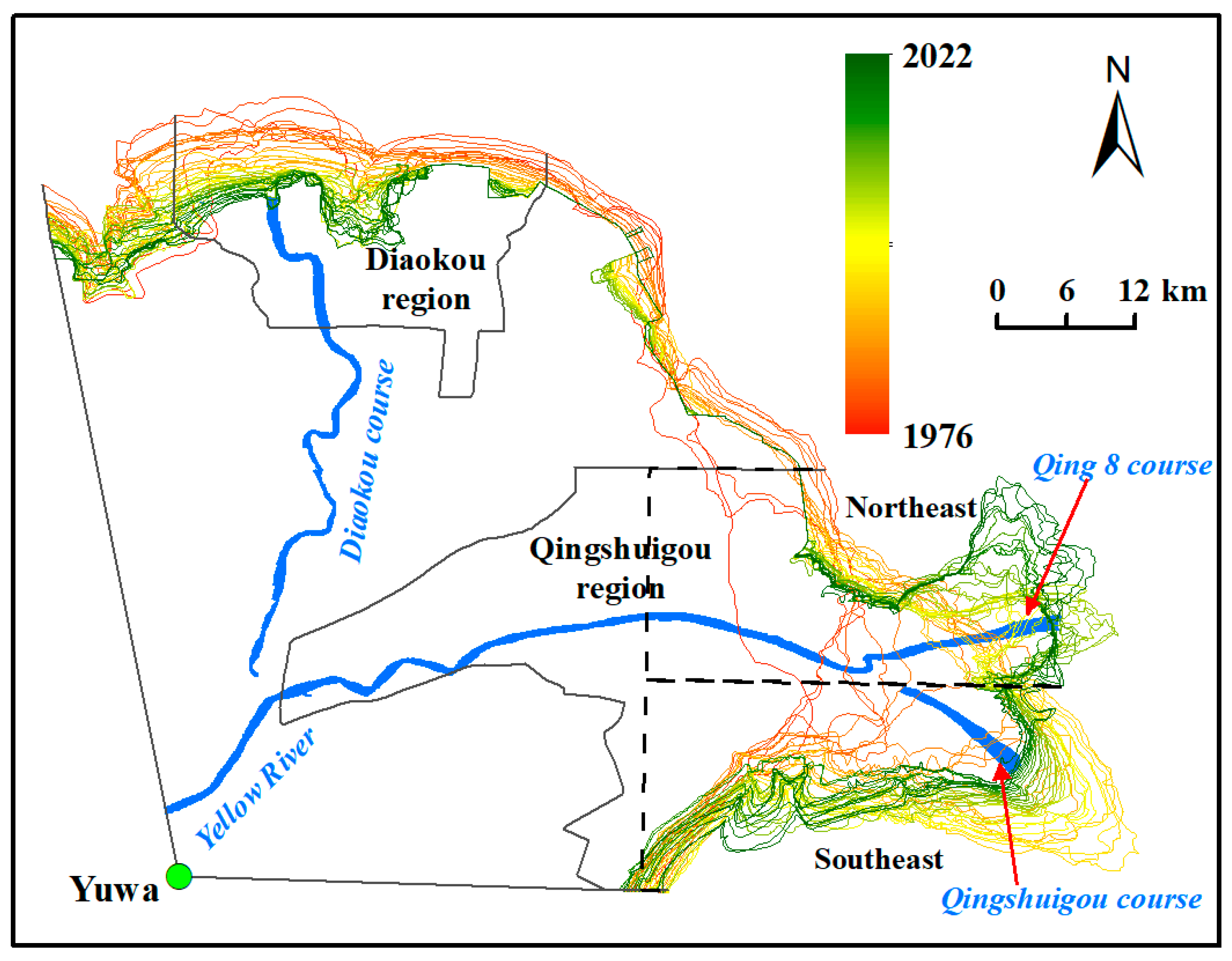




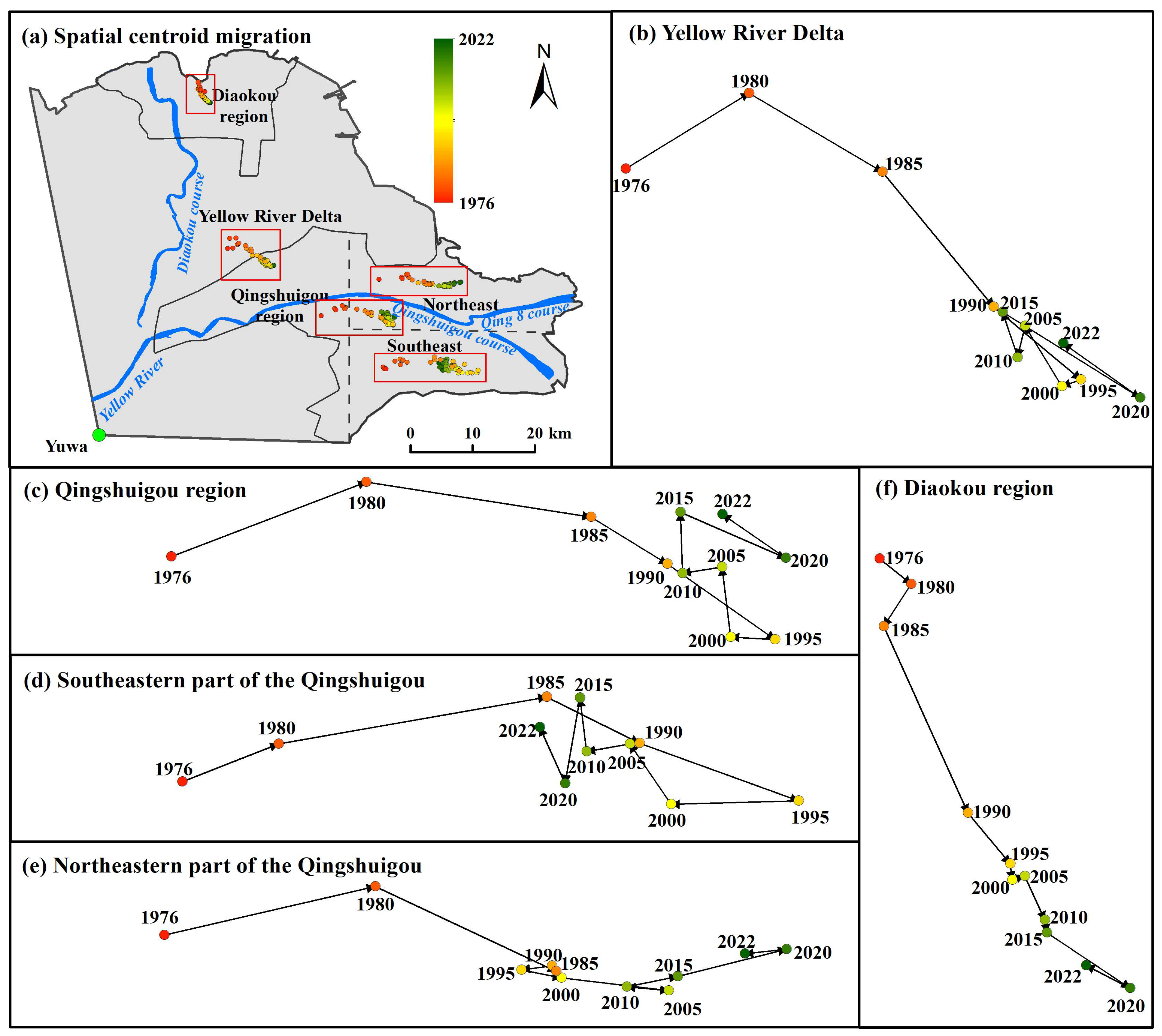
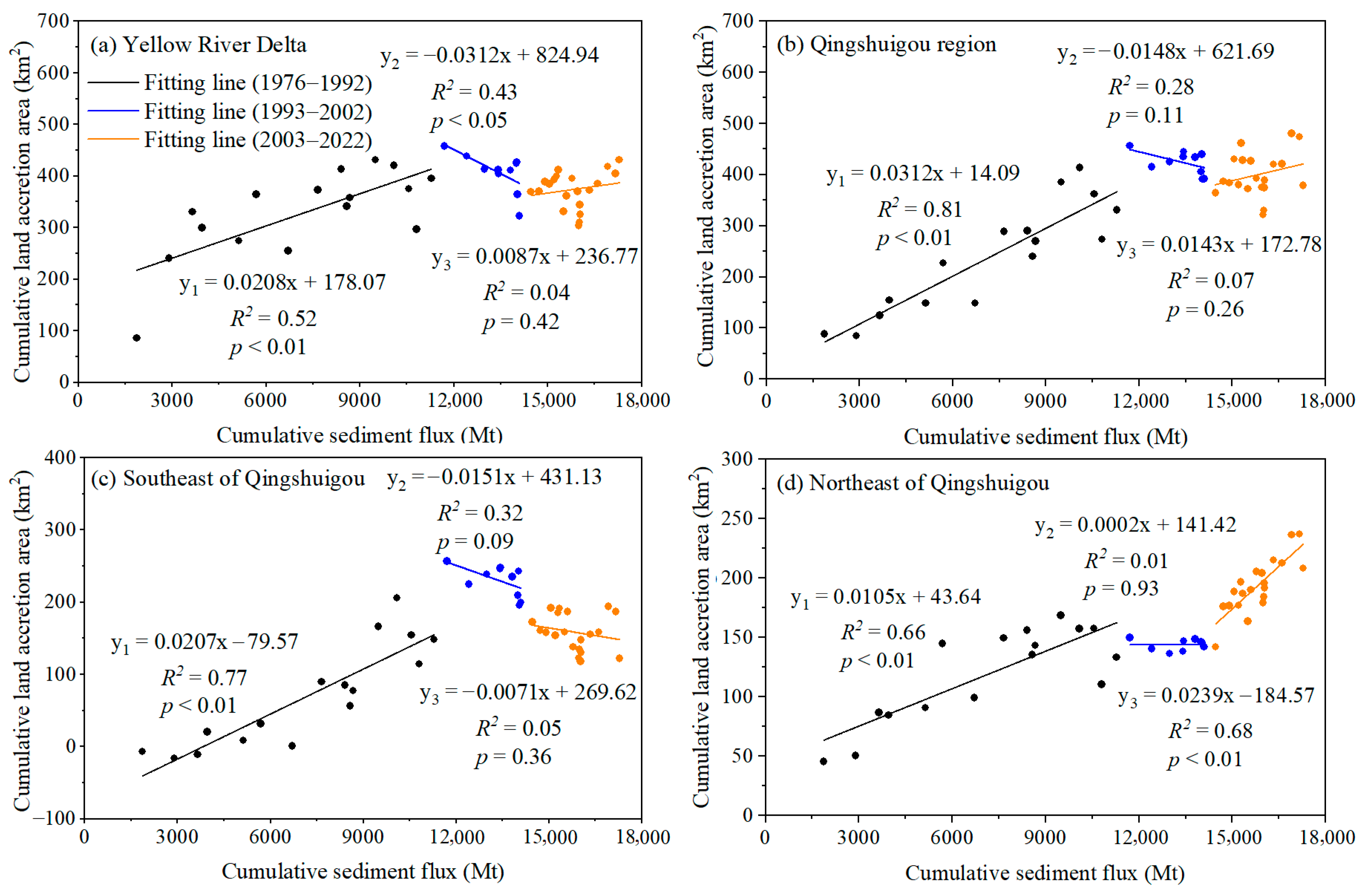
| ID | Image Date | Sensor Type | Bands | Resolution (m) | ID | Image Date | Sensor Type | Bands | Resolution (m) |
|---|---|---|---|---|---|---|---|---|---|
| 1 | 1976.08.31 | MSS | 4 | 80 | 25 | 2000.10.17 | TM | 7 | 30 |
| 2 | 1977.10.01 | MSS | 4 | 80 | 26 | 2001.10.12 | ETM+ | 8 | 30 |
| 3 | 1978.07.07 | MSS | 4 | 80 | 27 | 2002.09.29 | ETM+ | 8 | 30 |
| 4 | 1979.10.18 | MSS | 4 | 80 | 28 | 2003.10.26 | TM | 7 | 30 |
| 5 | 1980.07.14 | MSS | 4 | 80 | 29 | 2004.09.10 | TM | 7 | 30 |
| 6 | 1981.06.12 | MSS | 4 | 80 | 30 | 2005.10.15 | TM | 7 | 30 |
| 7 | 1982.02.01 | MSS | 4 | 80 | 31 | 2006.10.02 | TM | 7 | 30 |
| 8 | 1983.07.07 | MSS | 4 | 80 | 32 | 2007.06.15 | TM | 7 | 30 |
| 9 | 1984.07.17 | TM | 7 | 30 | 33 | 2008.10.07 | TM | 7 | 30 |
| 10 | 1985.11.25 | TM | 7 | 30 | 34 | 2009.08.23 | TM | 7 | 30 |
| 11 | 1986.06.05 | TM | 7 | 30 | 35 | 2010.09.11 | TM | 7 | 30 |
| 12 | 1987.06.08 | TM | 7 | 30 | 36 | 2011.09.22 | ETM+ | 8 | 30 |
| 13 | 1988.12.03 | TM | 7 | 30 | 37 | 2012.11.27 | ETM+ | 8 | 30 |
| 14 | 1989.11.20 | TM | 7 | 30 | 38 | 2013.09.03 | OLI | 9 | 30 |
| 15 | 1990.06.16 | TM | 7 | 30 | 39 | 2014.10.24 | OLI | 9 | 30 |
| 16 | 1991.10.09 | TM | 7 | 30 | 40 | 2015.10.27 | OLI | 9 | 30 |
| 17 | 1992.09.25 | TM | 7 | 30 | 41 | 2016.10.13 | OLI | 9 | 30 |
| 18 | 1993.10.30 | TM | 7 | 30 | 42 | 2017.09.30 | OLI | 9 | 30 |
| 19 | 1994.09.15 | TM | 7 | 30 | 43 | 2018.10.19 | OLI | 9 | 30 |
| 20 | 1995.09.18 | TM | 7 | 30 | 44 | 2019.08.19 | OLI | 9 | 30 |
| 21 | 1996.08.19 | TM | 7 | 30 | 45 | 2020.10.24 | OLI | 9 | 30 |
| 22 | 1997.10.09 | TM | 7 | 30 | 46 | 2021.11.12 | OLI | 9 | 30 |
| 23 | 1998.09.10 | TM | 7 | 30 | 47 | 2022.09.28 | OLI | 9 | 30 |
| 24 | 1999.08.28 | TM | 7 | 30 |
| Variable | Zmann-kendall | Significance Test |
|---|---|---|
| Water discharge | −1.16 | p > 0.05 |
| Sediment flux | −4.97 | p < 0.01 |
| Precipitation | 1.19 | p > 0.05 |
| Variable | Period | Maximum | Minimum | Mean | Zmann-kendal |
|---|---|---|---|---|---|
| Annual water discharge | 1976–1999 | 489.29 (1983) | 17.86 (1997) | 227.52 | −3.40 ** |
| 2000–2022 | 441.10 (2021) | 41.90 (2002) | 192.74 | 2.38 ** | |
| Annual sediment flux | 1976–1999 | 1169.27 (1981) | 15.38 (1997) | 583.26 | −3.10 ** |
| 2000–2022 | 369.00 (2003) | 7.70 (2017) | 142.99 | 0.53 |
Disclaimer/Publisher’s Note: The statements, opinions and data contained in all publications are solely those of the individual author(s) and contributor(s) and not of MDPI and/or the editor(s). MDPI and/or the editor(s) disclaim responsibility for any injury to people or property resulting from any ideas, methods, instructions or products referred to in the content. |
© 2025 by the authors. Licensee MDPI, Basel, Switzerland. This article is an open access article distributed under the terms and conditions of the Creative Commons Attribution (CC BY) license (https://creativecommons.org/licenses/by/4.0/).
Share and Cite
Yu, B.; Wu, C.; Zhao, Z. Impacts of Water and Sediment Fluxes into the Sea on Spatiotemporal Evolution of Coastal Zone in the Yellow River Delta. Land 2025, 14, 834. https://doi.org/10.3390/land14040834
Yu B, Wu C, Zhao Z. Impacts of Water and Sediment Fluxes into the Sea on Spatiotemporal Evolution of Coastal Zone in the Yellow River Delta. Land. 2025; 14(4):834. https://doi.org/10.3390/land14040834
Chicago/Turabian StyleYu, Bowei, Chunsheng Wu, and Zhonghe Zhao. 2025. "Impacts of Water and Sediment Fluxes into the Sea on Spatiotemporal Evolution of Coastal Zone in the Yellow River Delta" Land 14, no. 4: 834. https://doi.org/10.3390/land14040834
APA StyleYu, B., Wu, C., & Zhao, Z. (2025). Impacts of Water and Sediment Fluxes into the Sea on Spatiotemporal Evolution of Coastal Zone in the Yellow River Delta. Land, 14(4), 834. https://doi.org/10.3390/land14040834







